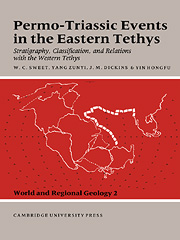 Permo-Triassic Events in the Eastern Tethys
Permo-Triassic Events in the Eastern Tethys Book contents
- Frontmatter
- Contents
- List of contributors
- Preface
- Acknowledgments
- 1 Permo-Triassic events in the eastern Tethys – an overview
- 2 Permo-Triassic boundary relations in South China
- 3 Permo-Triassic boundary of the Indian subcontinent and its intercontinental correlation
- 4 Permo-Triassic boundary on the Indian peninsula
- 5 The Permo-Triassic boundary in the southern and eastern USSR and its international correlation
- 6 Classification and correlation of nonmarine Permo-Triassic boundary in China
- 7 Permian and Triassic events in the continental domains of Mediterranean Europe
- 8 The Permo-Triassic boundary in the Southern Alps (Italy) and in adjacent Periadratic regions
- 9 Permo-Triassic brachiopod successions and events in South China
- 10 Conodont sequences in the Upper Permian and Lower Triassic of South China and the nature of conodont faunal changes at the systemic boundary
- 11 A conodont-based high-resolution biostratigraphy for the Permo-Triassic boundary interval
- 12 The palynofloral succession and palynological events in the Permo-Triassic boundary interval in Israel
- 13 The effects of volcanism on the Permo-Triassic mass extinction in South China
- 14 Geochemical constraints on the Permo-Triassic boundary event in South China
- 15 Permo-Triassic orogenic, paleoclimatic, and eustatic events and their implications for biotic alteration
- 16 Permo-Triassic boundary in Australia and New Zealand
- Index
6 - Classification and correlation of nonmarine Permo-Triassic boundary in China
Published online by Cambridge University Press: 12 October 2009
- Frontmatter
- Contents
- List of contributors
- Preface
- Acknowledgments
- 1 Permo-Triassic events in the eastern Tethys – an overview
- 2 Permo-Triassic boundary relations in South China
- 3 Permo-Triassic boundary of the Indian subcontinent and its intercontinental correlation
- 4 Permo-Triassic boundary on the Indian peninsula
- 5 The Permo-Triassic boundary in the southern and eastern USSR and its international correlation
- 6 Classification and correlation of nonmarine Permo-Triassic boundary in China
- 7 Permian and Triassic events in the continental domains of Mediterranean Europe
- 8 The Permo-Triassic boundary in the Southern Alps (Italy) and in adjacent Periadratic regions
- 9 Permo-Triassic brachiopod successions and events in South China
- 10 Conodont sequences in the Upper Permian and Lower Triassic of South China and the nature of conodont faunal changes at the systemic boundary
- 11 A conodont-based high-resolution biostratigraphy for the Permo-Triassic boundary interval
- 12 The palynofloral succession and palynological events in the Permo-Triassic boundary interval in Israel
- 13 The effects of volcanism on the Permo-Triassic mass extinction in South China
- 14 Geochemical constraints on the Permo-Triassic boundary event in South China
- 15 Permo-Triassic orogenic, paleoclimatic, and eustatic events and their implications for biotic alteration
- 16 Permo-Triassic boundary in Australia and New Zealand
- Index
Summary
Introduction
In China, nonmarine Permian and Triassic strata are distributed mainly in the vast area north of a line formed by the Kunlun, Qinling, and Dabie mountains. They are particularly well developed in the Junggar, Turpan, and Shaanxi-Gansu-Ningxia basins. South of the line, nonmarine Permo-Triassic sediments occur mostly in eastern Yunnan and western Guizhou. In addition, alternating marine and continental Permian and Triassic rocks are also developed in a few areas in both South and North China. In the past decade or so great progress has been made in studies of both the biological and nonbiological features of the nonmarine Permo-Triassic boundary. Existing data reveal distinct changes across the boundary in biologic groups such as vertebrates, bivalves, ostracodes, spores, pollen, and other flora, and in nonbiologic features such as grain size and color of sediments, sedimentary environments and climate. These changes suggest an event between the Permian and Triassic and can be applied to correlation of the nonmarine Permo-Triassic boundary.
Biotic changes
Determination of the Permo-Triassic boundary in nonmarine sequences is made at present mainly on the basis of vertebrates and spore-pollen assemblages, and to a lesser extent, on the basis of ostracodes, bivalves, and other elements of the flora.
Vertebrate fauna
The vertebrate fauna changes markedly from Permian to Triassic. Dicynodonts such as Kunpania scopulusa, Striodon magnus, Jimusaria sinkiangensis, Dicynodon tienshanensis, Jimusaria taoshuyanensis, Turfandon bogdaensis and Kansuodon sp. are represented in Upper Permian strata in the Junggar and Turpan basins of Xinjiang and Gansu provinces, northwest China (Zhao, 1980; Yang et al., 1986). A Pareiasaurus fauna, represented by Tapinocephalidae and Shihtienfenia permica, and Shansisaurus xuecunensis, has been reported from equivalent strata in Shanxi and Shaanxi provinces, North China.
Information
- Type
- Chapter
- Information
- Permo-Triassic Events in the Eastern TethysStratigraphy Classification and Relations with the Western Tethys, pp. 56 - 59Publisher: Cambridge University PressPrint publication year: 1992